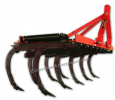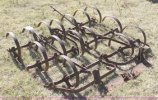I am thinking Spring already! I have many acres that I am trying to reclaim as food plots. Most of the acres have been covered in tag alder and willow, which I have cut down with my brush cutter. This spring I want begin prepping the soil for planting and I have been hearing conflicting views on the best way to do this. The soil has a good amount of clay with lots of rocks. Tag alder spreads by their roots and I have lots of those as well. I have heard that rotary tillers are slow, get clogged and damaged by roots and rocks. Discs are faster and less expensive, but don’t get the soil as smooth. Would love to hear your experience and recommendations, I can only afford one or the other.
I'm a big advocate of soil health. Tillage, depth and frequency, burn OM and destroy soil tilth. Google "Ray the soil guy" and watch some of his videos. Start with the short infiltration video. Ray's focus is on commercial farmers, but the principles hold true for food plots, and because we are different than farmers, we can get even more benefit from them. Next, read through the long Crimson n Camo Throw and Mow thread. He takes the principles that Ray (NRCS Soil Scientist) espouses and shows how to apply them with small equipment.
The reason I say to do this first is because I have equipment just sitting around collecting dust like a 2-bottom plow now that I know better. I'm still recovering from the damage I did with that and a tiller to my soil. After many years or rehabilitation, I'm now getting back to the point where I don't need fertilizer any more and I'm getting effective plots. The first rule is "do no harm".
So, once you've convinced yourself (I hope you do) that you are better off with long term success with soil health rather than short-term gain and long term headaches from traditional tillage, you'll need to understand the techniques. Generally less is better when it comes to soil-health and tillage.
The more fertile your soils is, the more it can handle the abuse of tillage. In big ag areas with highly productive soils, folks can get away with heavy tillage and it may take a lifetime and you still might not exhaust the soil. Most of us managing for deer are dealing with marginal soils. The more on the sandy or clay end of the spectrum you are, the less abuse your soil can take. Organic matter is key in these more marginal soils.
With sand, nutrients and water tend to move through the soil very fast. With clay then tend to move very slow. OM in either of these soils supports a microbiome that promotes nutrient cycling and tempers the movement of nutrients.
I have high clay content in my soils. Clay tends to form a crust if exposed to rain directly and that crust can inhibit some of the direct T&M techniques. Until the OM content is built up in your soil (that is another conversation about crop mixing and rotation selection), I find "Min-Tilling" effective in clay. There are different ways to do it. You can use a very light disc that scratches up the crust. You don't want it set too aggressive or be too heavy because you don't want to get any deeper than the top inch. Another very effective way to do it is with a tiller. I raise the 3-pt hitch enough so that the tines are barely touching the top inch. I move quite fast so the tiller does not spend much time in any one spot. The field looks more green than brown when I'm done. The tiller chews up the existing vegetation and throws a little soil around but the field does not look like a traditionally disked field.
When I started, I used to plow then run a tiller at full depth. I marveled proudly at how nice looking the seed bed was. How well the soil was ground up, not clods like a disk. It was fine and fluffy. I'd broadcast seed and then run the tiller over it with the PTO turned off to drag a bit of soil over the seed. I thought it was great, but I needed more and more fertilizer to keep crops growing. Finally a soil scientist pointed me to a recipe for building a good dirt road. It was exactly what I was doing. Grinding the soil up into tiny particles and the using a combination or rain and equipment weight to compress it. Never put a heavy tractor on wet clay soil. It compacts very easily.
We recently bought a fire disk. Even in its least aggressive setting, it disks too deep for my taste when it comes to min-till. A cheap light angle iron disc gets it about right for min-till.
So, both a disc and tiller will work, but which disc and how you use the tiller make a difference.
If you decide you really want to do the old traditional deep tillage approach, I'd suggest a heavy disk over a tiller. A disc is much faster than a tiller at full depth and tiller tines wear quickly when used that way. For min till, tine wear is much less of an issue. They don't wear as much when barely touching the top inch, Most of the contact is with vegetation. As they wear, you are simply not raising the hitch quite as high so you maintain that 1" level or less. It takes many years before they need replaced unlike traditional tillage.
Thanks,
Jack


